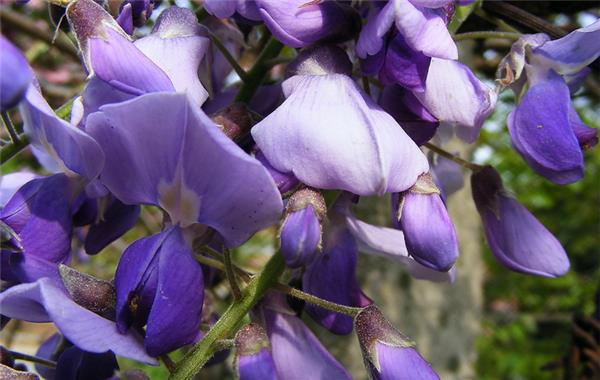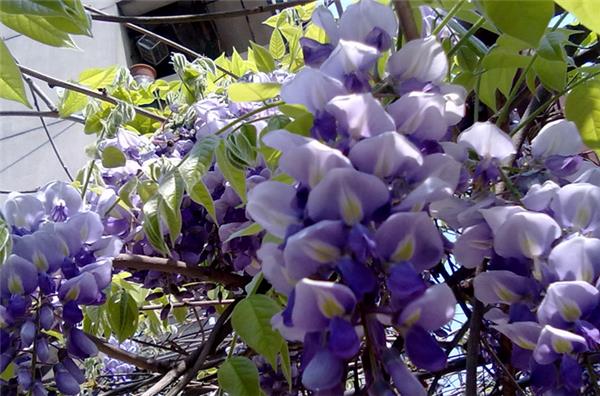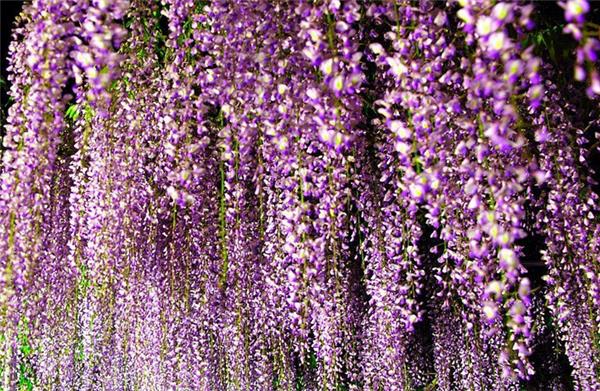[Cultivation of Wisteria] Precautions for cultivation of Wisteria
Wisteria is a kind of deciduous climbing and winding large vine, which blossoms in spring with a cyan-purple butterfly-shaped Corolla, purple or dark purple flowers, very beautiful, warm and temperate plants, strong adaptability to the growing environment. Do you want to know about this plant? do you want to know the cultivation method of wisteria? Then look down.

I. cultivation of wisteria
The cultivation methods of wisteria are sowing, cutting, striping and ramets, which have deep main roots and few lateral roots, and are not resistant to transplanting. After the seeds were collected, the seeds were dried and stored. The seeds were soaked for about 12 hours before sowing in the next spring, and the seedlings were sowed and raised in the open field seedbed. The Beginning of Autumn after a moderate interval of seedlings, three years later out of the nursery, seedlings should be moved with soil balls.
Wisteria cultivation can also select 1-year-old strong branches in early spring to cut into 15 to 20 meters for cuttings, dozens of bundles, buried in the leeward and sunny wet area at the upper end, 10 meters of soil cover, covered with plastic film for heat preservation and moisturization. The cuttings were dug out in early May with a high survival rate and rapid seedling formation. The broken root cut at the beginning of the seedling can also be used for root insertion propagation. Ramet propagation should be operated when winter buds begin to sprout in spring, and when digging roots and tillers, we must dig deeply.

II. Pruning and maintenance of wisteria flowers
The main purpose of dormant pruning is to adjust the rattan type, make its growth trend fixed, properly thinning branches to facilitate the use of nutritional space, and delete some non-flowering branches.
Post-anthesis pruning can use strong pruning of branches in the first year and erasing too many sprouts to properly reduce the height and ensure the shrub shape and the growth of a sufficient number of strong branches in the same year. After autumn, the branches were properly cut and thinned before flower bud differentiation, so as to retain the lower buds of long branches and differentiate into flower buds.
After the defoliation in winter, the plant is pruned comprehensively, the dry and dead branches are cut off, and the branches of the current year are cut short by 1 to 2, so that they are different in length and scattered. Winter moves to the cold room or overwinters in the outdoor shelter from the wind and the sun, keeping the basin soil free of ice to survive the winter safely. After sprouting in spring, the over-dense buds are wiped out in time, so that nutrients are concentrated on the remaining branches, which is beneficial to flowering. Turn the basin before sprouting every 1-2 years, remove part of the old soil when turning the basin, and put some rotten animal hooves, bone dregs and other fertilizers with high phosphorus content in the basin bottom as base fertilizer. The basin soil should be slightly acidic soil with loose and fertile soil and good drainage.

Third, how to cultivate wisteria in order to blossom and flourish
Wisteria has sufficient light, slightly shade tolerance, cold tolerance, early tolerance, strong adaptability to soil, and can grow under the condition of thin sore and solid topsoil.
In order to cultivate wisteria, to make it blossom and flourish year after year, fertilizer and water management should be strengthened. When planting, you should choose a high dry place with good drainage. Where there is stagnant water, it is easy to rot. After planting, organic fertilizer was applied every 2-3 years to increase soil nutrients during the dormant period.
The weather in the north is dry and early in early spring, which is the budding stage, so it should be watered frequently. After entering autumn, you should also pour enough frozen water to prepare for overwintering. If the winter water is insufficient, the weather is too dry in the early spring of the following year, and the branches will dry up.
During the dormant period in winter and spring, pruning should be carried out, the distribution of branches should be adjusted, and overdense branches and weak branches should be cut off from the base, so that the structure of the main vine and lateral vine of the tree is symmetrical and clear, and all parts can be ventilated and transparent. During the growth period, summer pruning can be carried out after flowering, mainly cutting off dense branches, tapping and coring the new branches to control overgrowth.

Wisteria has dense branches and leaves and beautiful flowers, which are often used to climb flower racks, green corridors, dead trees or rocks, etc., and can also be made into a graceful cliff-style bonsai, which is placed on several tall shelves and on top of bookcases, full of flowers and trees, and the old piles are horizontal and oblique.
- Prev

[rubber trees raised in water] can rubber trees be raised in water?
[rubber trees raised in water] can rubber trees be raised in water?
- Next

[how much water does it take to raise bamboo water] Bamboo water culture method
[how much water does it take to raise bamboo water] Bamboo water culture method
Related
- Wuhan Hospital Iron Tree Blooming Result Was Instantly Frightened by the Gardener Master
- Which variety of camellia is the most fragrant and best? Which one do you like best?
- What is the small blue coat, the breeding methods and matters needing attention of the succulent plant
- Dormancy time and maintenance management of succulent plants during dormancy
- Minas succulent how to raise, Minas succulent plant pictures
- What are the varieties of winter succulent plants
- How to raise succulent plants in twelve rolls? let's take a look at some experience of breeding twelve rolls.
- Attention should be paid to water control for succulent plants during dormant period (winter and summer)
- Watering experience of twelve rolls of succulent plants
- Techniques for fertilizing succulent plants. An article will let you know how to fertilize succulent plants.

